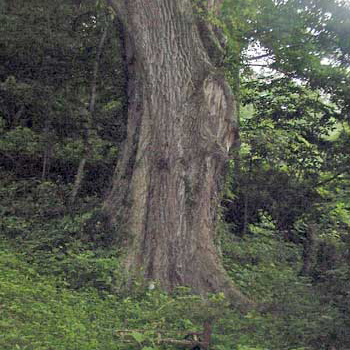Contributing Writer - Carol Herwig, Volunteer Coordinator
Since Washington, DC’s origin as the nation’s capital, trees were a key element in the plan. George Washington (a noted plantsman) and planner Pierre L’Enfant envisioned tree-lined streets and parks. Thomas Jefferson bemoaned the loss of native groves, and followed up with a sketch and a planting of Lombardy poplars that, unfortunately, were spectacularly unsuited for Washington’s climate.
But the American elm,
Ulmus americana, was already here, along with white pine and white oak and other native species. A mature elm can grow 60 to 80 feet tall with strong limbs creating a vase-shaped spread nearly equal to its height. The elm has an interlocking grain that is resistant to splitting, which made it valuable for wagon wheel hubs. Its wood is also resistant to rot in wet conditions.
So many of those big native elms were lost to the building of the city, cut down for timber. The Civil War further decimated Washington’s tree canopy, as most trees were felled to build the circle of forts that defended the capital.
The focus on Washington as a tree-lined city returned in the mid-1870s, post-Civil War, when Governor Alexander “Boss” Shepherd laid out his grand plan for the city: planting 60,000 trees, building sidewalks and installing curbs. Shepherd created a “parking commission,” a precursor to the District Department of Transportation, that was responsible for planting and maintaining the city’s trees. Shepherd’s term barely lasted two years, but the modern DDOT agency continues to be responsible for city trees though its Urban Forestry Administration.
Shepherd’s plan was the beginning of what we now know as the historic elm corridors. Streets were planted each with a single species, ignoring the risk of losing whole blocks to disease. This monoculture approach to tree planting only made the spread of Dutch elm disease easier when it arrived in the early 20th century and many elm-lined DC streets were decimated. Remnants can be found throughout the city: along South Carolina Avenue in the Southeast, to Branch Avenue east of the river, to the state streets, New Hampshire, Arkansas, Kansas and Illinois, in the Northwest. Often diseased trees were replaced by Japanese zelkovas or Chinese elms and more recently by disease-resistant cultivars of the American Elm. But there are some grand survivors — at the southeast corner of Lafayette Park; along the western edge of Rock Creek Cemetery; on the Capitol Grounds; along the West Potomac Park waterfront and of course, on the National Mall.
Washington’s world-famous elms — the double allees on the Mall — are part of the McMillan Commission plan, influenced by Western Europe’s great avenues. Elms were chosen by the McMillan Commission because of the “architectural character of its columnar trunk and the delicate traceries formed by its wide-spreading branches.” Installation of the plan began in 1902 and was largely complete by 1922, after a pause for World War I.
 |
| Elms and the Lincoln Memorial in the snow. |
The American Elm is a classic native tree of our city although it certainly has seen better days. At Casey Trees we are committed to maintaining and restoring the legacy of the American Elm as a street tree, which is why we have been planting over 1,750 elms in the city since 2003. Learn more about our American Elm Restoration program
on our website.





















